The Aprilia Mana 850 GT has excellent handling and braking and good fuel economy.
It also has an easy-to-live-with CVT transmission.
So does this make it a city bike, or an upgraded type of scooter?
Or, is it a basic all-around street bike?
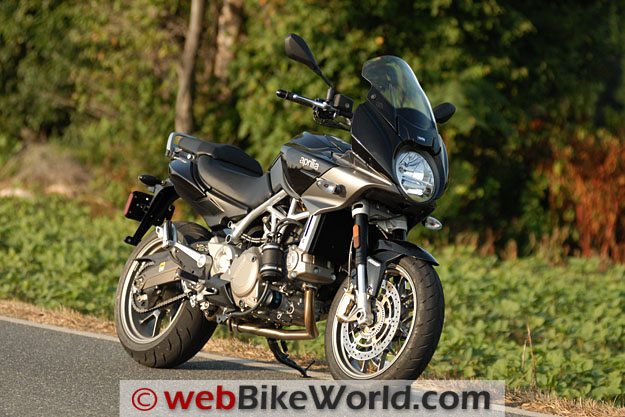
Background
Who would refuse the loan of a brand-spanking-new motorcycle for a month? Not me.
So when Kenn Stamp, the Editor of 2WF.com recruited me for another, the answer was “Yes” before the sentence left his mouth.
I’m on call 24/7, ready any time to review a new motorcycle…all in the interest of our webBikeWorld visitors, of course.
This time, it was the Aprilia Mana 850 GT ABS. Kind of a mouthful and isn’t “mana” the stuff that came down from heaven to feed the Israelites when they were hanging out in the desert?
There were no Golden Arches back then, you know. Ummm, wait — actually, that was “manna”, now that I think about it.
Mana is supposed to be a word to describe the power, or “juice” that resides in supernatural, spiritual or powerful people.
I’m not sure if that’s what the Aprilians had in mind for this bike; if so, it’s a good example of hyperbole. But…there have been stranger names for motorcycles.
Besides the name, this bike is different, that’s for sure.
After I agreed to run up to Allentown, Pennsylvania to pick it up, I figured I’d better take a peek at the specs and do a quick read of HBC’s Mana 850 review (the base model) from 2009. That’s when I remembered about the CVT.
Aprilia seems a bit reticent at calling the transmission a CVT.
They sometimes refer to it as a “sportgear transmission” and sometimes as a “sequential/automatic transmission”. But peel away the layers of marketing propaganda and eventually they call it a CVT.
I never rode a bike with a CVT before and I wondered if I’d be reaching for a clutch lever and coming up with air every time.
I thought for sure I’d be flubbing takeoffs left and right — after all, the left side of my body has been programmed for umpty-ump years to clutch ‘n’ shift. It’s difficult to imagine what life would be like without it.
What a surprise! Not once — not one single time did I reach for the clutch or shifter.
But an even bigger surprise was this: not once did I miss them, either. One ride on the Mana 850 GT and you’ll wonder why all motorcycles aren’t like this. At least I did…
OK, so the CVT is the showcase feature of the Mana 850 GT — but what about the bike that surrounds it? Well, let’s take a look…
Mana For the Masses
I get the sense that Aprilia’s marketing strategy for the Mana 850 is a bit schizophrenic.
Actually, so is the bike. I wonder if Aprilia knows what they have in the GT version of the Mana 850 — like what is the target market for this bike and what would motivate someone to buy it.
Aprilia uses vague marketing-speak phrases when referring to the GT.
That includes stuff like calling it “a completely new motorcycling concept” and “the new frontier, the missing link in an evolution that makes the world of motorcycling and its emotions accessible to all types of users”.
Huh? That one’s definitely a non-starter with the beer and peanuts crowd.
This is a problem.
The Mana 850 GT does have a few unique benefits, but like everything else in today’s hyperkinetic marketplace, the ability to sell one requires a laser-focused strategy targeted to a very specific market segment and a crystal-clear explanation of the features and benefits.
All in about 10 seconds or less. Less.
So here’s my tip to Aprilia: Forget about trying to sell this bike as a motorcycle replacement for scooter owners or as an urbanite fad bike. Forget the “all things to all people” strategy too.
And definitely can those “emotions” that are “accessible to all types of users”.
After living with the Mana 850 GT for a month, I see something different.
The CVT is a gem and the bike is, oh, about 85 percent of the way to being a very interesting and unique sport-tourer. If I were in charge, that’s where the focus would be.
Give it an adjustable windscreen (and a couple of windscreen options), a nice set of bags with hard mounting points and a top box and maybe even replace the chain with a belt drive.
Do all that and I think you’d end up with one of the sweetest sport-tourers on the road.
But I’m getting ahead of myself here. So let me take you through a recap of my thoughts after living with this very cool and very unusual bike for a month or so…
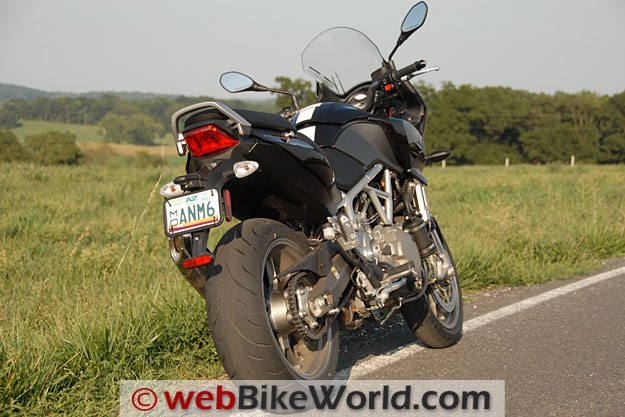
Mana 850 GT Styling and Design
The build quality of this bike is fantastic; it literally felt like it was carved from a steel billet — and all of the other Aprilias I have handled feel just as good.
It’s too bad the retail network — at least in the U.S.A. — is so thin.
If more people had an Aprilia dealer nearby (and if I didn’t have to drive all the way up to Allentown, Pennsylvania to find a dealer), I bet Piaggio would sell a lot more bikes.
Especially so when the potential customer could compare one handlebar-to-handlebar in a showroom with other makes…
Aprilia build quality reminds me of early Hinckley Triumph — overbuild it to completely bury any preconceived notions of British (or Italian) quality.
For example, little items like braided stainless steel fuel lines, machined rather than stamped brackets hidden in places you’d never find them and high-quality hardware make a big difference and add to the solid presence of this motorcycle.
The styling of the Mana GT variant doesn’t help a potential owner understand the bike either, unfortunately.
It’s a combination of 21st Century modern with a touch of 1980’s mullet in the fairing, which looks out of place with the character of the bike.
The round headlight is the problem; it doesn’t jive with the sharp lines that dominate everything aft of the triple clamp. Style me up a pair of cool-looking razor-sharp headlights up front and you’d have it.
And speaking of the fairing, that windscreen has to go. Aprilia told me there are no optional windscreens, which is too bad, because the stock screen dumps turbulent air where it’s least wanted — right smack dab on the chin.
This causes a huge amount of wind noise, starting at a low 20 MPH and getting worse from there. At 60+ MPH, it’s nearly unbearable when wearing any type of helmet.
The stock screen is adjustable, more or less (less).
Two bolts on either side are loosened to move the windscreen up or down about 25 mm total, but it’s not enough to smooth the air flow by any means.
This would be an easy problem to solve for an owner, however. If the bike were mine, the first order of business would be to break out the Dremel, cut the windscreen in half and sand and polish the top edge.
Done and booming gone.
I didn’t think Aprilia would care much for testing that theory on a brand-new loaner bike though, so the Dremel stayed in the drawer.
The CVT and Me
Since the transmission is the raison d’être for the Mana 850 series, I will address it first. I wasn’t sure how quickly I’d be able to adapt to it — or if I’d be able to adapt at all.
But on the very first ride, I quickly realized it would not be a problem.
In fact, about 1 kilometer into it, I had a head-smacking moment. Shifting is overrated! Who needs it?!
I never imagined I’d feel this way; in fact, I’d guess that many motorcyclists would have the same amount of skepticism for an “automatic” bike. Perhaps things would be different if the implementation of the technology wasn’t as good.
After all, Aprilia has years of experience with this type of transmission in building their extensive line of “twist and go” scooters.
There are a couple of minor differences to note before heading out on the Mana 850 GT.
It starts just like any other modern motorcycle — turn on the ignition, wait for the sweep of the speedometer indicator and for all of the lights to blink on and off as the computer boots up.
Then press the start button to engage.
The nicely-mapped fuel injection gets the GT started and idling smoothly with no problems. But here’s where the differences begin. With the side stand down, blip the throttle and…the engine dies.
It’s designed to to that, because there is no “neutral” or its equivalent.
With the sidestand up, remember that the bike is a twist-and-go — if you twist, you’re going.
There’s no standing next to the bike in the garage to blip the throttle; in fact, you can’t blip the throttle at all, whether you’re riding or not. Imagine a bike that’s always in gear and you’ll get the picture.
If you think about it, that’s no different than a car with an automatic transmission.
There is one difference, however.
With the Aprilia’s engine at idle and no brake applied, the computer makes sure that the bike doesn’t creep forward like it might in a car.
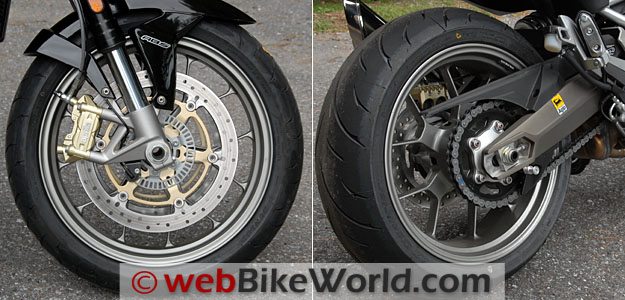
The CVT Stress Reduction Plan?
When you’re ready to go, simply twist the throttle and the bike starts moving. The first time is a very unique and liberating feeling and gets even easier after that.
Aprilia has done a great job in mapping the fuel injection to match the characteristics of the CVT.
There is a slight difference from a normal takeoff in that it takes a larger handful of throttle than one might expect to get the CVT engaged, but that’s actually a good thing.
The fuel delivery has been made especially soft for startup and the first few miles-per-hour to avoid any jerkiness in the driveline.
I quickly realized that not having to deal with shifting and clutch work reduces the subconscious stress levels and work load, if you can call it that, on the rider.
This is where the concept of a CVT transmission on a motorcycle really comes into its own. No worrying about which gear is correct and no decisions about downshifting or upshifting. Simply enjoy the ride and focus on throttle control and braking.
I immediately found myself a much smoother rider and I also had a lot of fun, which is another reason why this system would make an excellent sport tourer, especially when riding with a passenger.
No more helmet-knocking in the stop-and-go’s because the smooth application of power and the CVT makes for a completely fluid and seamless ride.
It’s also an excellent system for slow speeds, like winding your way through a national park at a 10 MPH speed limit while gawking at the flora and fauna.
No jerking back and forth, no throttle on/off whiplash and no worries about having to shift up and down to keep in the correct RPM zone.
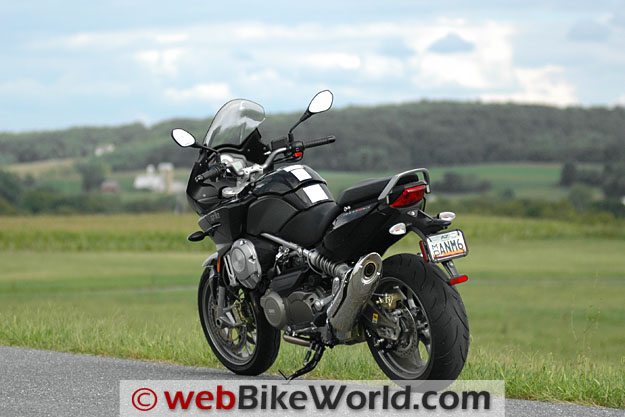
Missing Bits
Speaking of RPMs, one of the very big nits I have to pick with this bike is the lack of a tachometer. I think this was a big oversight by Aprilia.
I actually called the Aprilia technical person to confirm this and the answer was “Yes, we have no tachometer”.
It’s not like there’s no extra room on the dashboard; in fact, the instrument binnacle looks a bit lonesome behind the big fairing, with only the speedo and computer display.
And the bike actually has a lap timer (a lap timer?) but no tach.
Making a sport-tourer out of the Mana 850 GT could mean plugging in some optional dials.
That would be things like water temperature (rather than the simple thermometer graphic that shows up on the monochromatic computer screen), a Voltmeter, outside temperature gauge or more. But I’m dreaming again…
The absence of a tach means I can’t tell you how the bike performed at different RPMs, because I have no idea how many R’s, P’s or M’s we were turning in the various CVT settings.
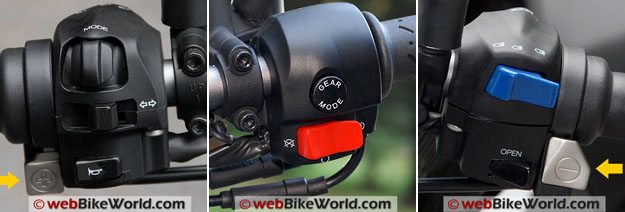
Riding the Mana 850 GT
The bike starts up in the CVT “Touring” mode, which is equivalent to a smooth automatic, with a good compromise of acceleration, torque and speed.
There’s also a “Sport” mode; a “Rain” mode and a “Sport Gear” mode.
The “Gear Mode” button on the right handgrip (see photos above) cycles the transmission through each mode and it can be pressed any time the engine is running, whether the bike is in motion or not.
From Touring mode, press and hold the Gear Mode button for about 1 second to change to “Sport”.
This mode is the equivalent of dropping down about 2 gears in the CVT, but I rarely used it because it made the bike feel too frenetic and it brought to the fore one of the problems with the 839 cc, 90-degree V-twin engine: it’s a real vibrator.
Using Sport mode means putting the engine in the worst of the vibe range, effectively cancelling any fun one might have by the lower gearing, so in this case, Sport does not equal fun.
Ditto for the “Sport Gear” mode, which is accessed at any time by pressing and holding the Gear Mode button for 2 seconds or so.
Sport Gear puts the CVT into a faux gear mode and allows the rider to choose one of 7 different gears, just like a “normal” bike.
The gears are selected by pushing the up/down paddles on the left handgrip or by using the vestigial shift lever at the left foot.
The foot lever is an anachronism on this bike and after trying it once to see what it did, I never used it again.
Besides the vibes, Sport Gear mode seemed kind of silly; after all, it’s more fun not to shift, so why do I want to start concentrating on that again? And the absence of a tach doesn’t add to the fun either.
There’s one more mode in the cycle: “Rain”.
I’m not really sure what this one does; apparently, it’s supposed to temper the fueling and transmission for riding on wet roads.
But to me it felt more like it placed the CVT half-way between Sport mode and Touring. After trying it once or twice, I didn’t use the Rain mode at all, even during a long homeward stint in am actual rain storm.
Another feature hidden in the system is a semi-manual “gear” selection.
The Touring and Sport modes have an override and the bike can be downshifted by pressing the front button on the left grip (or the foot shift lever).
But the override doesn’t allow the transmission to shift up, only down, which seems strange to me. Why not allow it to override up or down, and maybe allow a quick tap of the Gear Mode button to cancel and return to automatic?
One quirk about the location of the shift paddles is that they can occasionally be activated by accident if the rider’s left hand is choked up on the inner side of the hand grip.
On quick blasts of acceleration, tightening my grip would sometimes trigger a downshift.
The turn signal lever on the left hand grip is a bit of a reach also; the button sticks out too far for my thumb, so I had to take my hand off the grip to reach for the turn signal button every time I wanted to use it.
Same on the right-hand side with the Gear Mode button. These are minor irritants, but there nonetheless.
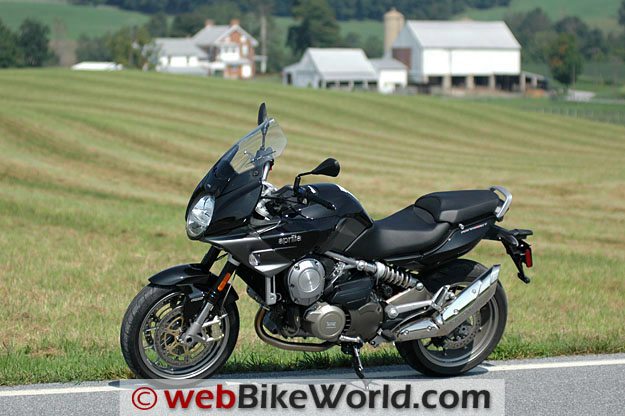
Handling, Brakes and Suspension
I’d have to say that the Aprilia Mana 850 GT is the sweetest handling motorcycle I’ve ever had the pleasure to ride. It has absolutely no bad habits and it feels perfectly neutral.
The word “neutral” is used quite frequently to describe motorcycle handling, but very few bikes really have it.
Tell the GT where to go and it does it precisely without fuss and without even the tiniest hint of oversteer or understeer, neither feeling ponderous or flighty.
This makes a huge difference in comfort levels and in the feeling of security. The combination of the superb build quality and the perfectly neutral handling makes the bike feel rock-solid under any condition.
The front suspension has no settings, so what you see is what you get. That was fine by me, although the front on this Aprilia could probably use a touch less compression stiffness for those short jolts.
I once spent days messing about with a fully adjustable Suzuki GSXR and never really noticed a difference and I’ll pretty much guarantee the vast majority of street riders feel the same.
So not having an adjustable front end is a benefit, as far as I’m concerned.
The rear suspension is easily adjustable via the control seen in the photos. It was set pretty stiff when I got the bike (with 200 miles on the odometer) and I loosened it up a bit.
Again, not much of a difference other than a touch more plushness over those same short jolting bumps.
The big 180/55 mm Dunlop Sportmax Qualifier rear tire looks good and works even better. It feels very secure and planted the road with noticeably excellent grip.
I haven’t been on Dunlops for some time and these tires are terrific, so they will definitely be on my shopping list next time I need tires.
The brakes are another outstanding feature of the Mana 850 GT. The big 320 mm floating discs up front have radial-mounted calipers that look like they might have come right from Max Biaggi’s RSV4.
They are very powerful but very easy to use and also very progressive. The rear brake gets the same kudos, with a 260 mm and braided stainless steel brake lines front and rear.
The Mana 850 GT also has ABS, with a dual-channel Continental system. It works seamlessly and it hauls this bike down in a hurry with no muss or fuss.
I tried it on a variety of surfaces, including loose gravel and sand on some of the back farm roads you can see in the photos and it made me a true believer in ABS for street bikes.
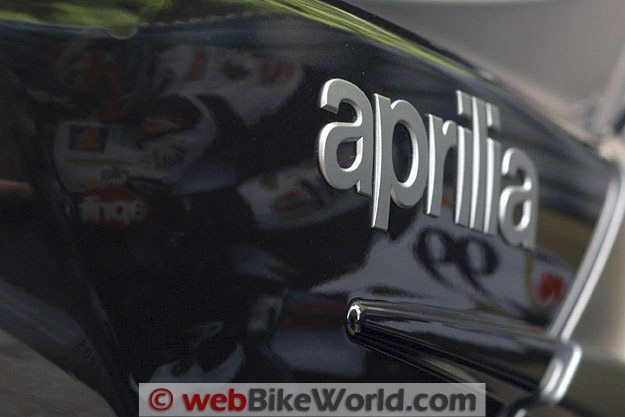
Picks and Pans
The other very useful scooter-like feature of the Mana 850 GT is the fuel tank that isn’t.
What looks like a fuel tank is really a decent-sized storage compartment, big enough to hold a lot of gear but not a full-sized helmet.
I’m not sure who’d want to carry a full sized helmet in there anyway, but as you can see in the slide show photos, an XL-sized Arai Quantum doesn’t fit.
But the storage area is very handy and it even has a little night light that turns on when the lid is popped.
That’s the pick; here’s the pan: the storage compartment opens by pushing a lever on the back of the left-hand grip assembly. But the ignition has to be on for it to work.
So every time I wanted to open the compartment, which is every time I got on the bike, I had to turn the ignition on, press the button to pop the storage compartment lid, then turn the key off.
This is a real pain; I think Aprilia should revise the design so the button opens the compartment at any time but it can be locked if desired or make it functional whenever the key is in the ignition.
There is one other way to open the storage compartment. There’s a key hole in the tail of the bike, just above the stop light, to open the pillion seat. The fuel tank lives under there.
Take the key out of the ignition, open the seat and a manual lever can be operated to pop the compartment. But that’s even more of a pain.
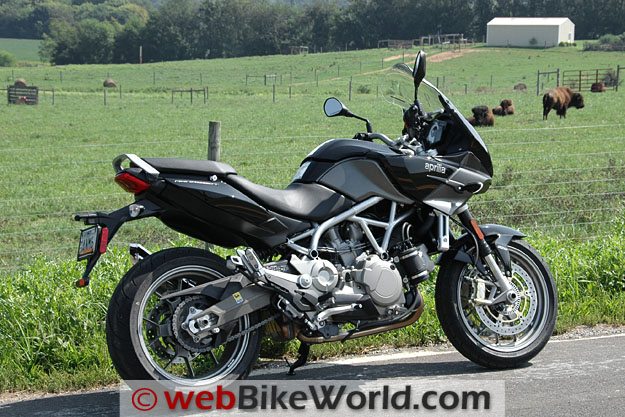
Fuel, Mileage and Computing
Fueling the bike means pulling the key from the ignition, putting it in the tail and popping the back seat.
It isn’t that big of a problem for refueling, and having the fuel tank opening at lower-than-waist level makes it easy to use and to see what’s going on.
Speaking of fuel, I got a consistent 42 to 44 MPG with the Mana, no matter what type of road, fast or slow, highway or byway.
I guess that’s decent mileage for a bike that’s a touch on the heavy side (Aprilia doesn’t list a weight, but it feels heavy pushing around the garage) with a CVT.
Besides the absence of a tachometer, the LCD computer screen would be a heck of a lot nicer if it were in color.
I guess that’s asking too much, but the stock screen can get washed out, surprisingly not when the sun is shining on it, but when I’m riding into the sun. The sun reflects off my jacket and puts a lot of glare on the semi-gloss screen.
The computer can be cycled through a few settings, showing the real-time MPG, average MPG, speed (not needed because it’s also displayed on the analog speedometer), average speed and the time.
When Sport Gear is chosen, the current “gear” shows on the display.
It’s not really a gear, but the CVT is programmed to mimic a gear. The count goes up to 7 and switching from one gear to the next happens nearly instantaneously.
Some customization can be done by selecting the menu with the “Mode” button. Lap times, strangely enough, can be recorded. But no tachometer can be displayed.
More good stuff includes the seating position, which is a bit cramped for anyone 6 ft. tall and over but perfect for shorter folks.
The handlebars are also perfectly placed for a bike of this type, making for a controlled and relaxed ride.
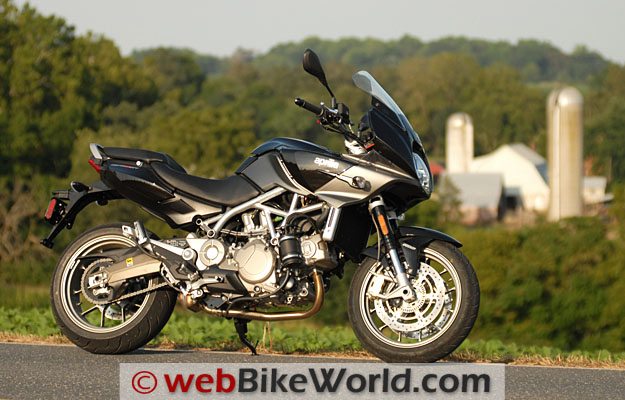
Conclusion
I had a lot of fun during my month with the Aprilia Mana 850 GT.
I took to the CVT transmission like a duck to water; the build quality is superb; the handling is rock-solid and the brakes should be an example for every other motorcycle.
I didn’t care for the windscreen and the round headlight seems at odds with the otherwise angular styling.
The bike also desperately needs a tach and I’m not sure what type of luggage options are available and I do think a belt would suit the bike better than a chain.
I do think that Aprilia could and should focus the Mana 850 GT on sport touring or light touring.
It would be an easy step to take; it would help put a focus on the target market; and I think it would put the bike on the wish list of a much larger audience.
One thing’s for sure: you owe it to yourself to take that trip to your nearest Aprilia dealer to check out their 2010 lineup. I sat on the Dorsoduro, the RSV 4 and the Tuono 1000 R at the dealership and was very impressed.
Publication Date: September 2010
| 2010 Aprilia Mana 850 GT – Specifications | |
|---|---|
| Engine | |
| Engine: 90° V-twin, 4 stroke, liquid cooled, single overhead cam with chain drive, four valves per cylinder. | |
| Displacement: 839.3 cc | |
| Bore/Stroke: 88 x 69 mm | |
| Engine Torque: 73 Nm at 5,000 RPM | |
| Horsepower: 56 kW at 8,000 RPM | |
| Fueling: Integrated electronic engine management system. Weber Marelli electronic injection with 38-mm throttle body. | |
| Ignition: Digital electronic, two spark plugs per cylinder, integrated with fuel injection system. | |
| Compression Ratio: 10.0:1 | |
| Exhaust: 2 into 1; 100% stainless steel with three-way catalytic converter and lambda probe. | |
| Lubrication: Dry sump system with separate oil tank. | |
| Alternator: 450W a 6000 RPM | |
| Transmission | |
| Gear box: Sequential with manual or automatic mode selectable by the user. 7 ratios in manual mode. 3 mappings (Touring – Sport – Rain) in Autodrive mode. Gear change by pedal or handlebar control. The user can switch from automatic to sequential mode and vice versa at any time. | |
| Clutch: Automatic | |
| Primary drive: Belt | |
| Final drive: Chain | |
| Wheels, Tires, Chassis | |
| Frame: High-strength steel trellis. | |
| Front suspension: Upside-down fork with 43 mm stanchions. Wheel travel 120 mm. | |
| Rear suspension: Single- piece aluminum alloy swingarm. Shock absorber with adjustable spring preload and rebound damping. Wheel travel 125 mm. | |
| Wheels: Cast Aluminum | |
| Tires: Radials, tubeless. Front: 120/70 ZR 17. Rear: 180/55 ZR 17. | |
| Wheels: Aluminum alloy Front: 3.50 X 17″ Rear: 6.00 x 17″ | |
| Brakes | |
| ABS: 2-channel Continental ABS system. | |
| Front Brakes: Dual 320 mm diameter stainless steel floating discs. Radial calipers with four pistons. | |
| Rear Brake: 260 mm stainless steel disc. Single piston caliper. | |
| Dimensions, Weights and Capacities | |
| Maximum Length: 2,080 mm | |
| Maximum Width: 800 mm (at handlebars) | |
| Maximum Height: 1,270 mm (1,320 mm at rear-view mirrors) | |
| Saddle Height: 800 mm | |
| Wheelbase: 1,463 mm | |
| Trail: 101 mm | |
| Steering Angle: 24° | |
| Fuel tank capacity: 16 liters | |
| Colors | |
| Black, White | |
| Price | |
| List Price: $10,599.00 | |
| Review Date: September 2010 | |
More wBW Motorcycle Reviews | All wBW Motorcycle Product Review
Owner Comments and Feedback
See details on submitting comments.
From “L.F.” (01/11): “I got my Aprilia Man 850 GT with ABS in Hong Kong about a month ago and have done about 700 km. It is an excellent bike to ride but the downside are:
A lack of an RPM counter for a bike of this price bracket; A lack of an accurate fuel gauge and water temp gauge; and A trip computer that tells you a lot of useless information but does not tell you how many miles you have got left before the next fuel. The useless wind deflector creates more noise than it is worth.
All that is forgiven because 1) the automatic transmission is excellent and 2) the ride is absolutely first class.
I am looking for an after market wind deflector and a slightly more “noisy” exhaust to take away the gentleness of the bike. My other bike is a Harley Davidson 2005 Fat Boy which has straight pipes and loads of after market conversions Thanks.”
From “T.S.” (10/10): “Many thanks for the informative and, may I say, unusually sincere, review of the Aprila Mana 850 GT.
My particular interest in the Mana is because I’m a Suzuki Burgman 650 owner. You are probably aware that the Burgman also has a CVT transmission. Your test reveals many similarities between the two bikes.
Yes, the Burgman is technically a scooter, but the aesthetics is where it all stops. I’ve owned 15 motorcycles in my life, and the Burgman is the finest “motorcycle” of the bunch.
I also never imagined I’d feel so good about an automatic transmission on a motorcycle, but 5 miles down the road, and I was hooked. Aprilia and Suzuki have been making quality scooters for many years, and now their respective technologies are blending together well.
The Mana 850 feature which kills the engine if the throttle is blipped with the kickstand down is an excellent idea. I can’t tell you how many times a well-meaning buddy would grab the throttle at idle, ready to twist, while I’m having heart failure trying to stop him. At first, I found it a real pain that Suzuki won’t allow the motor to run with the kickstand down, but now I see the logic.
The Burgman 650 has the “manual mode” and paddle shifters, which aren’t that interesting after trying it a few times – exactly what you said about the Mana. There is also a “Power” mode on the Burgman 650, dropping the RPM’s about 1000 at any speed. This is good for blasting from stoplight to stoplight, or embarrassing a Harley owner in a drag race, but not much else. Like you said about the Mana, it’s a rarely used feature.
The Burgman does have a tachometer, of sorts, which is a LCD “stripe” across the top of the speedometer, punctuated by 1k RPM increments. I do use it, but less than you’d think. There is also an ambient temperature gage, which alternates with the clock display.
One of your readers asked about engine braking. This is extremely noticeable on the Burgman 650, and takes a while to learn, but can actually be used to scrub off speed while approaching a red-light or upcoming turn. Frankly, I’d prefer a more “free wheeling” effect, like a “normal” motorcycle, but I’ve learned to adapt to the quirky Burgman feel. Funny thing, though …when shifting in manual mode, all braking effect goes away, letting it coast freely between gears.
After riding the CVT Burgman 650 for 36,000 miles, I’ve grown accustomed to it’s ways …. and I absolutely love the CVT. Who needs shifting anyway – it’s all so highly overrated.
Unfortunately, the Burgman 650 is a scooter competing in a motorcycle market. If Aprilia made the changes you recommended, I’d probably swap the Burgman for a Mana 850. The prices are fairly close, and so are the features. I just love the full-fairing and mirrors on the Burgman, plus it will hold TWO full-face helmets under the seat.”
From “S.S.” (10/10): “Thanks for the review of the Mana. I have one of those Hinckley Classic Triples, so I understand about the build quality comment.
One thing I have always wondered about the CVT bikes, and something I didn’t see addressed in your comments was the deceleration characteristics of this design. Specifically, do you still have engine braking, and if so, does the suspension have to be designed differently to accommodate the difference between a decelerating CVT versus a decelerating conventional transmission?”
Rick’s Reply: Good question, and I never even thought about it when I had the bike. Thinking back, I can not remember noticing anything different about the engine braking characteristics — I think there was a reasonable amount of engine braking, but I’m not sure. Let’s put it this way, I didn’t notice anything unusual, or I’m sure I would have recorded it in my notes.
Also, the brakes are so good on the bike that it didn’t seem to matter. If I recall correctly, I think also if it’s in Sport or Sport Gear mode, the normal engine braking can be felt, but again, I don’t remember one way or another that there was anything unusual.
Perhaps a Mana owner has some feedback on this topic to share?
From “K.S.” (10/10): “First, thanks to you, Rick, and the staff for a great review site. It is the best on the web, and in print media.
I have read all of the English language reviews of this bike (and its ‘non-GT’ predecessor), and yours is the most objective and thoughtful to date. A couple comments follow.
Several owners have reported their full-face, and 3/4, helmets fit in the false tank compartment. But several do not, as you discovered with your XL size noggin.
Several owners have installed hard and soft cases. Aprilia does offer a pannier frame and side hard cases, and the top box mount and several boxes are available (Givi). These observations are via the Aprilia Forum. The forum for all things Aprilia.
The weak Aprilia USA dealer network appears to be a case of recent (2007-2009) over-selling and under-delivering by Piaggio – and, of course, the fallout from the Great Recession. Only the strong, and committed to the brand, have survived. This appears to be sorting out somewhat this year, but it will still be few and far between for some owners.
One doesn’t need a tachometer with an automatic. This critique, and your bulls-eye about Aprilia’s obtuse marketing of the bike are all related to the ‘motorcycles must be manual’ psychology. I’m sure some PhD candidate could do their thesis on this one. One Mana owner has summed this issue up with his vanity license plate: ‘Y SHIFT’.”
Editor’s Reply: Thanks for the feedback. Regarding the tach, I still think it needs one; even the cheapest automatic cars have one! I definitely missed having it on the bike, especially in the Sport and Sport Gear mode, where the rider has no idea at all about the relationship between speed and RPM.
I’d easily swap the useless lap timer on the Mana for a tach. In fact, now that I think about it, I’d probably argue that a shifting street bike could probably do without a tach, I can pretty much always tell by the sound and feel which gear I’m in or when it’s time to up or down shift, and as I think about it, I rarely ever look at the tach on my bikes!
In any case, simply adding a tach might reduce the “weirdness” of the Mana to potential customers…


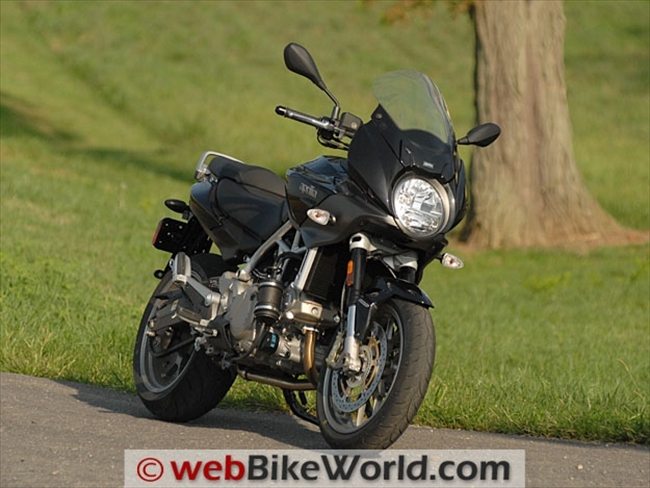
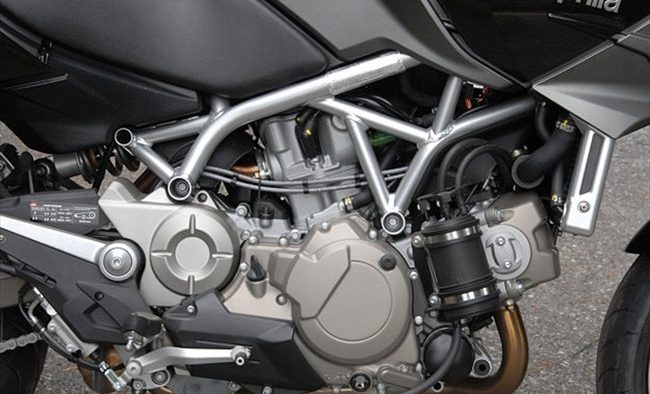
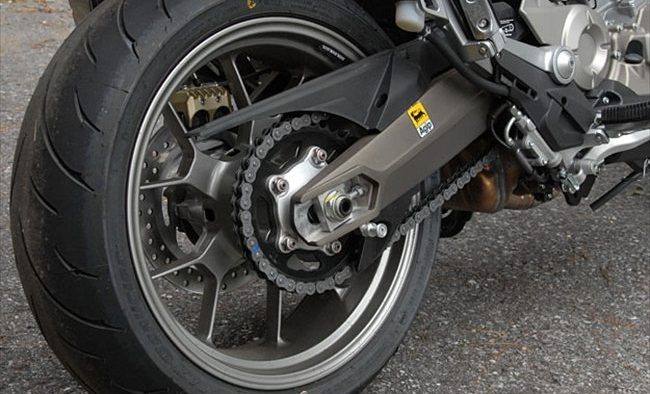

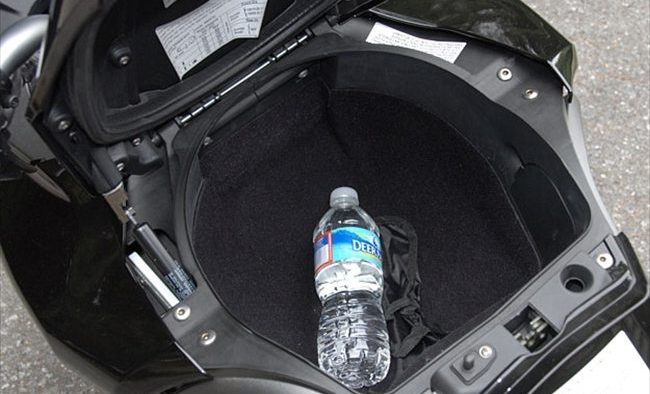
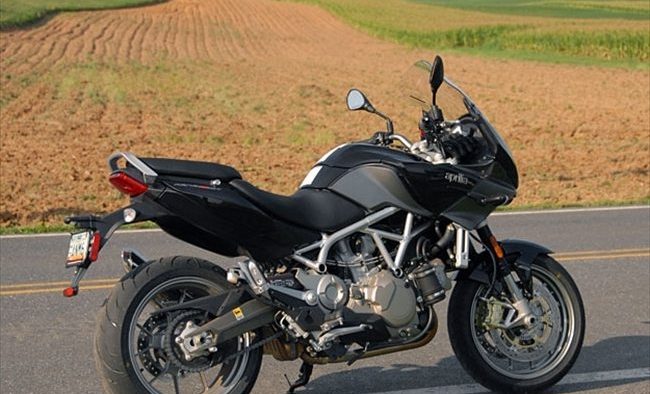
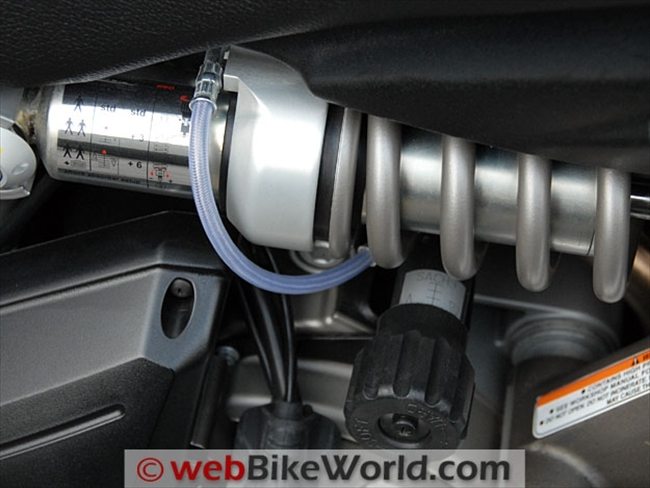
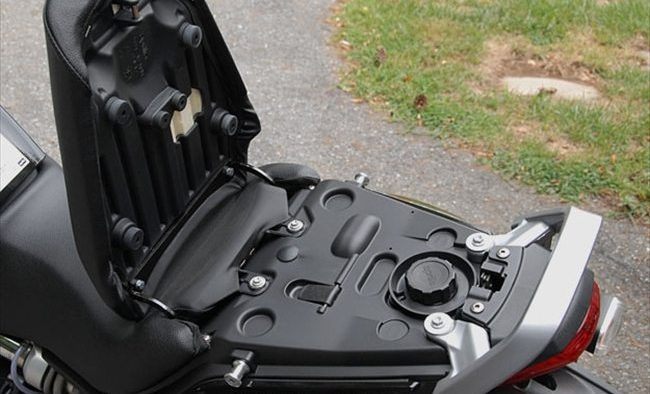
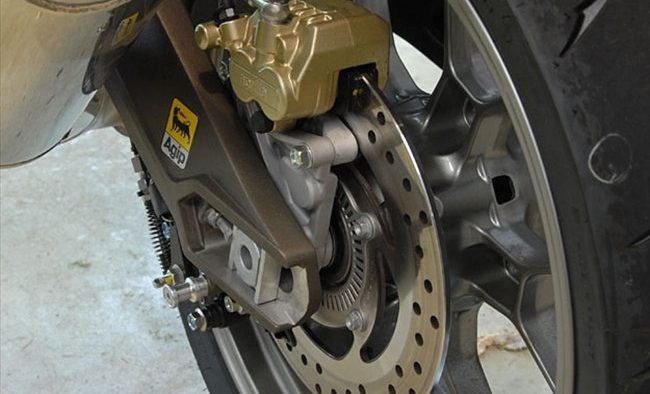
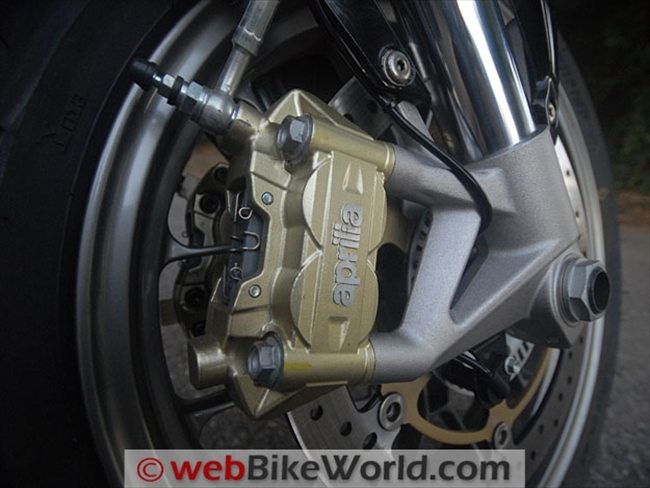
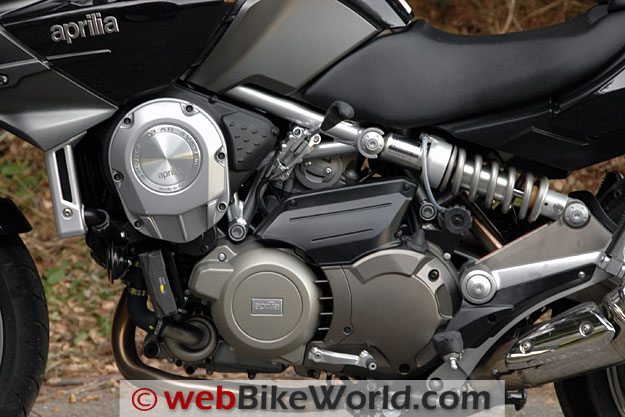

I’ve owned one for two years, sold it, now after a year want another. What an ace bike and I’m sad they are not made anymore.
Nothing against other than I’m 6’2″ and would like a bit more leg room. But for anyone under 5’11” they are made in heaven. Build quality 11/10, handling 10/10 and with an Akropovic they sound great. What would I change, well, the makers minds in bringing it back into production. A bike before it’s time, perhaps the World is ready for it now!
Excellent review – really enjoyed reading it. I had a Triumph Sprint RS (955c) from new but after an aneurism in my left leg could not change gear with my left foot (changing down was ok of course). Someone recommended I try a CVT bike and a used 850 GT ABS Mana was available from a local trader. One testdrive around the block was all I needed to buy it.
I’d like to correct you on the faux petrol tank however. It does take a full-size helmet but you need to put it into the box with the visor pointing upwards! It goes in easily but appears to be to too high for the ‘tank’. No worries the tank lid is shaped to allow for it. The ‘tank’ must be empty so your water bottle has to be removed but you can open the visor of the helmet and store stuff in the helmet itself. I have put a hard-wired trickle charger in mine (the battery is in there) and my helmet accommodates that and my gloves with ease.
Mine has a centre stand which is great though getting the bike on and off it in my weakened state demonstrates how heavy the bike is! So I use the side stand when I am not storing the bike and put on the hand brake which is conveniently positioned next to the left side of the seat when applied and is tucked away when released.
You can see the knob in the side view of the engine above.